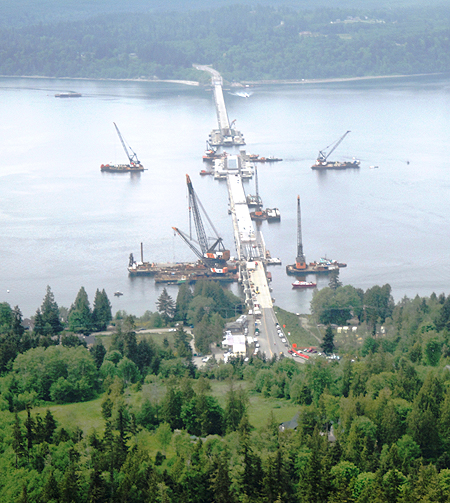
 |
|
Public works: Bridges |

Photo courtesy of Kiewit-General Joint Venture
The Hood Canal floating bridge is supported by 14 concrete pontoons with walls only 10 inches thick in most places.
Hood Canal Bridge retrofit |
|
Location: Port Gamble
|
|
The 7,850-foot-long Hood Canal Bridge has been renovated over the past six years, and its east half was completely replaced. Ready-mix concrete was the principal material used in its construction. Much of the roadway is supported by 14 concrete pontoons. Their walls are only 10 inches thick in most places to make them light enough to float. A variety of concrete mixes were used for the work, including lower-cost mixes where possible. The pontoon concrete, though, was a high-strength mix designed to minimize cracks and maximize impermeability. Curing methods were designed and put to use that will further minimize hairline cracking. Post-tensioning was also used to add strength and stiffness to the pontoon structures, and to compress the concrete. The floating portion of the bridge is held in place by 20 reinforced concrete anchors, each of which is attached to the bridge with a double 3-inch-diameter steel cable. The anchors consist of reinforced concrete shells that resemble giant mugs, each weighing up to 1,000 tons. The anchors are filled with crushed rock and are held in position by their weight. A total of 46.6 million pounds of concrete was used to build the 20 anchors, which are 29 feet tall and range from 46 to 56 feet in diameter. The bridge has been designed to allow the addition of another lane in the future.
|
|
Copyright ©2010
Seattle Daily Journal and DJC.COM. Comments? Questions? Contact us. |